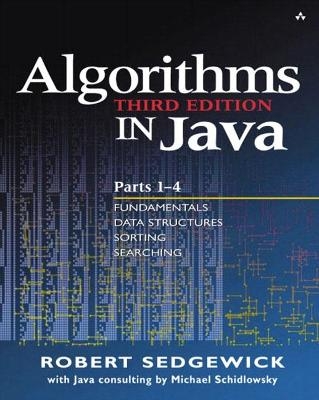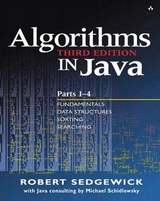Algorithms in Java, Parts 1-4
Addison Wesley (Verlag)
978-0-201-36120-9 (ISBN)
- Keine Verlagsinformationen verfügbar
- Artikel merken
For the first time, Sedgewick's seminal work on algorithms and data structures is available with implementations in Java. Michael Schidlowsky and Sedgewick have developed new Java code that both expresses the methods in a concise and direct manner, and also provides programmers with the practical means to test them on real applications. This particular book, Parts 1-4, represents the essential first half of Sedgewick's complete work. Its four parts are fundamentals, data structures, sorting, and searching. It has expanded coverage of arrays, linked lists, strings, trees, ADT's, and object-oriented programming.
Robert Sedgewick is the William O. Baker Professor of Computer Science at Princeton University. He is a Director of Adobe Systems and has served on the research staffs at Xerox PARC, IDA, and INRIA. He earned his Ph.D from Stanford University under Donald E. Knuth. 0201361205AB06262002
I. FUNDAMENTALS.
1. Introduction.
Algorithms.
A Sample Problem: Connectivity.
Union-Find Algorithms.
Perspective.
Summary of Topics.
2. Principles of Algorithm Analysis.
Implementation and Empirical Analysis.
Analysis of Algorithms.
Growth of Functions.
Big-Oh notation.
Basic Recurrences.
Examples of Algorithm Analysis.
Guarantees, Predictions, and Limitations.
II. DATA STRUCTURES.
3. Elementary Data Structures.
Building Blocks.
Arrays.
Linked Lists.
Elementary List Processing.
Memory Allocation for Lists.
Strings.
Compound Data Structures.
4. Abstract Data Types.
Collections of Items.
Pushdown Stack ADT.
Examples of Stack ADT Clients.
Stack ADT Implementations.
Generic Implementations.
Creation of a New ADT.
FIFO Queues and Generalized Queues.
Duplicate and Index Items.
First-Class ADTs.
Application-Based ADT Example.
Perspective.
5. Recursion and Trees.
Recursive Algorithms.
Divide and Conquer.
Dynamic Programming.
Trees.
Mathematical Properties of Trees.
Tree Traversal.
Recursive Binary-Tree Algorithms.
Graph Traversal.
Perspective.
III. SORTING.
6. Elementary Sorting Methods.
Rules of the Game.
Generic Sort Implementations.
Selection Sort.
Insertion Sort.
Bubble Sort.
Performance Characteristics of Elementary Sorts.
Algorithm Visualization.
Shellsort.
Sorting Linked Lists.
Key-Indexed Counting.
7. Quicksort 315.
The Basic Algorithm.
Performance Characteristics of Quicksort.
Stack Size.
Small Subfiles.
Median-of-Three Partitioning.
Duplicate Keys.
Strings and Vectors.
Selection.
8. Merging and Mergesort.
Two-Way Merging.
Abstract In-Place Merge.
Top-Down Mergesort.
Improvements to the Basic Algorithm.
Bottom-Up Mergesort.
Performance Characteristics of Mergesort.
Linked-List Implementations of Mergesort.
Recursion Revisited.
9. Priority Queues and Heapsort.
Elementary Implementations.
Heap Data Structure.
Algorithms on Heaps.
Heapsort.
Priority-Queue ADT.
Priority Queues for Index Items.
Binomial Queues.
10. Radix Sorting.
Bits, Bytes, and Words.
Binary Quicksort.
MSD Radix Sort.
Three-Way Radix Quicksort.
LSD Radix Sort.
Performance Characteristics of Radix Sorts.
Sublinear-Time Sorts.
11. Special-Purpose Sorts.
Batcher's Odd-Even Mergesort.
Sorting Networks.
Sorting In Place.
External Sorting.
Sort-Merge Implementations.
Parallel Sort-Merge.
IV. SEARCHING.
12. Symbol Tables and BSTs.
Symbol-Table Abstract Data Type.
Key-Indexed Search.
Sequential Search.
Binary Search.
Index Implementations with Symbol Tables.
Binary Search Trees.
Performance Characteristics of BSTs.
Insertion at the Root in BSTs.
BST Implementations of Other ADT Functions.
13. Balanced Trees.
Randomized BSTs.
Splay BSTs.
Top-Down 2-3-4 Trees.
Red-Black Trees.
Skip Lists.
Performance Characteristics.
14. Hashing.
Hash Functions.
Separate Chaining.
Linear Probing.
Double Hashing.
Dynamic Hash Tables.
Perspective.
15. Radix Search.
Digital Search Trees.
Tries.
Patricia Tries.
Multiway Tries and TSTs.
Text-String-Index Applications.
16. External Searching.
Rules of the Game.
Indexed Sequential Access.
B Trees.
Extendible Hashing.
Perspective.
Appendix.
Index. 0201361205T06262002
| Erscheint lt. Verlag | 5.8.2002 |
|---|---|
| Mitarbeit |
Herausgeber (Serie): JOHN FULLER |
| Verlagsort | Harlow |
| Sprache | englisch |
| Maße | 198 x 232 mm |
| Gewicht | 1200 g |
| Themenwelt | Mathematik / Informatik ► Informatik ► Datenbanken |
| Informatik ► Programmiersprachen / -werkzeuge ► Java | |
| Mathematik / Informatik ► Informatik ► Theorie / Studium | |
| Mathematik / Informatik ► Informatik ► Web / Internet | |
| ISBN-10 | 0-201-36120-5 / 0201361205 |
| ISBN-13 | 978-0-201-36120-9 / 9780201361209 |
| Zustand | Neuware |
| Haben Sie eine Frage zum Produkt? |
aus dem Bereich





